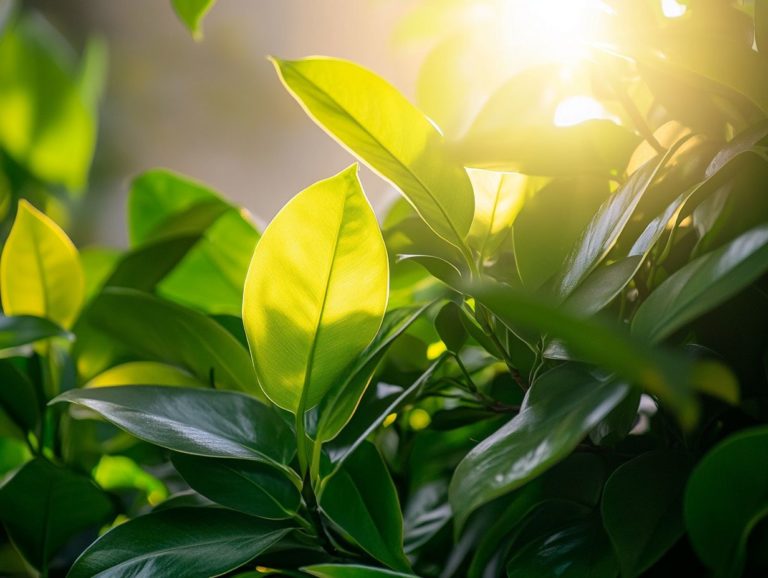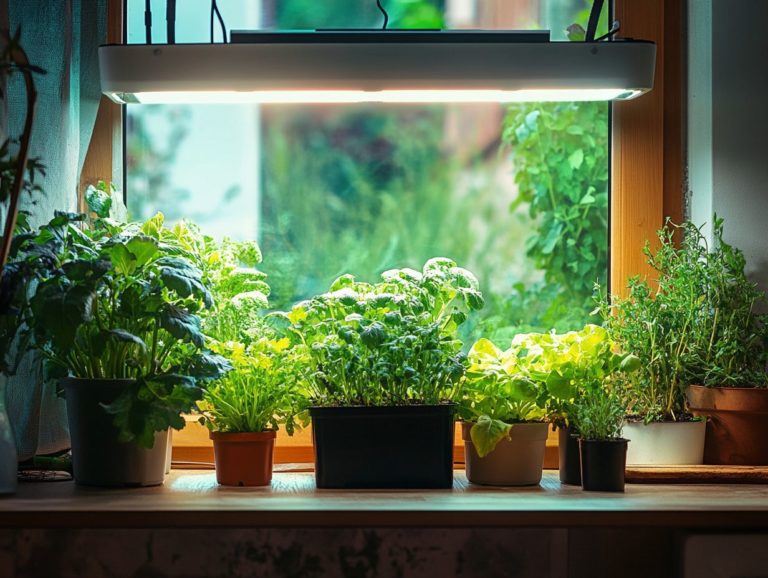How to Use Timers for Grow Lights
Grow light timers are essential tools for anyone engaged in indoor gardening, aiming to enhance plant growth and maximize energy efficiency. You will also find that embracing timers brings a multitude of advantages, from maintaining regulated light cycles to significantly cutting down on energy costs. This article will walk you through the various types of timers available and offer guidance on selecting the perfect one for your unique setup.
Prepare to take your gardening to the next level! You ll discover a step-by-step guide for setup along with troubleshooting tips designed to keep your plants flourishing.
Contents
- Key Takeaways:
- Benefits of Using Timers for Grow Lights
- Types of Grow Light Timers
- Factors to Consider When Choosing a Timer
- How to Set Up and Use a Grow Light Timer
- Troubleshooting Common Issues with Grow Light Timers
- Frequently Asked Questions
- What are timers and why are they important for grow lights?
- How do I set up a timer for my grow lights?
- Can I use a regular household timer for my grow lights?
- How often should I change the timer settings for my grow lights?
- Can I use multiple timers for my grow lights?
- What is the benefit of using timers for my grow lights?
Key Takeaways:
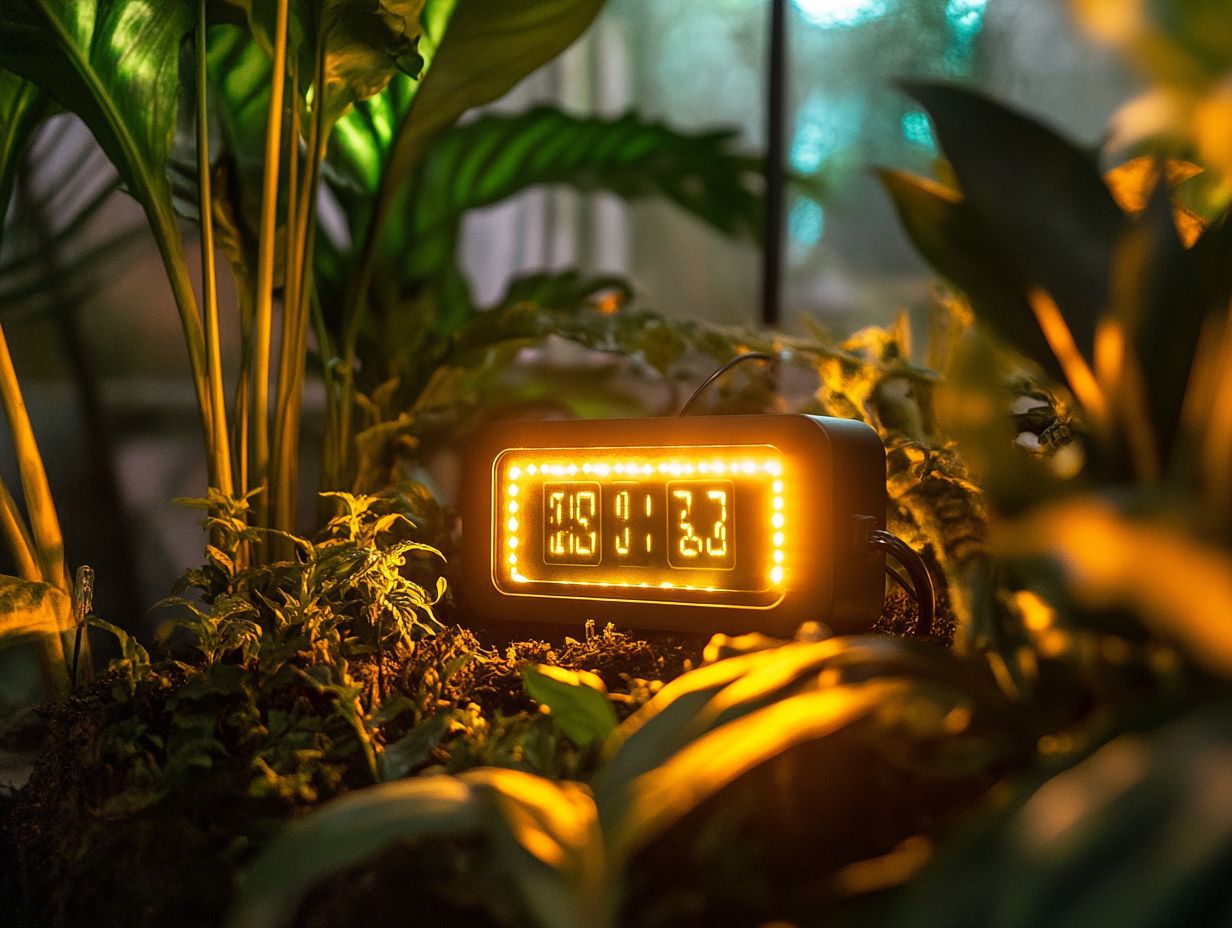
- Proper use of timers for grow lights can lead to efficient energy usage and regulated light cycles for plants.
- When choosing a timer, consider compatibility with your grow light system and available features for customization.
- Follow a step-by-step guide for setting up and using your timer to avoid common issues and maximize its benefits for your plants.
Unlocking the Power of Grow Light Timers!
Grow light timers are the cutting-edge tools you ve been waiting for to automate your indoor plant lighting schedule, ensuring they bask in just the right amount of light for optimal growth. By carefully regulating how long and how intensely your plants are illuminated, these timers not only enhance their health but also promote efficient energy use.
As you step into 2024, grasping the functionality of these devices can be key for your gardening success, especially in controlled environments where every detail of light and growth conditions can be finely tuned.
With these automated systems, you can easily set specific on and off times, which is invaluable for mimicking the natural cycles of sunlight. The integration of grow light timers streamlines your indoor gardening experience, ultimately boosting efficiency by minimizing the need for constant manual adjustments.
This technology is especially advantageous for seedlings, herbs, and flowering plants that have unique light requirements to thrive.
When paired with energy-efficient LED lights, these timers not only foster healthier plant development but also align with sustainable gardening practices, helping to reduce electricity consumption and your overall environmental footprint.
Benefits of Using Timers for Grow Lights
Utilizing timers for grow lights offers a host of advantages that can truly elevate your indoor gardening experience, dramatically improving both energy efficiency and plant growth. By automating your lighting schedule, these timers guarantee that your plants receive consistent light exposure an essential factor for photosynthesis, the process by which plants use sunlight to create food, and overall vitality.
They also help you manage electricity costs effectively, enabling you to optimize your setup for maximum yield without the burden of excessive energy bills.
Efficient Energy Usage
Efficient energy usage is crucial for indoor gardeners, and incorporating grow light timers can yield significant energy savings over time. By automating the on and off cycles based on a preset schedule, these timers help you minimize energy waste while ensuring your plants receive the optimal light they need for robust growth all without unnecessary energy consumption.
This thoughtful strategy not only enhances plant health but can also lead to noticeable reductions in your electricity bills. Research indicates that using timers can cut energy consumption related to grow lights by as much as 30%. By allowing you to customize lighting cycles to match the specific needs of your plants, you can effectively prevent issues of overexposure and underexposure, both of which can result in wasted energy and less-than-stellar growth.
The synergy of efficiency and precise timing can significantly boost the overall yield of your indoor garden, creating a win-win scenario for both the environment and your gardening endeavors.
Regulated Light Cycles for Plants
Regulated light cycles are essential for maintaining plant health. Using grow light timers is key to achieving that balance.
These timers help you simulate natural light conditions, vital for photosynthesis and growth cycles, resulting in healthier plants.
Plant species have unique light needs based on their environments. For example, tropical plants thrive with lots of light, while shade-loving varieties prefer less.
Understanding these light needs is crucial. Poor light cycles can cause stunted growth, poor flowering, or even death of your plants.
Types of Grow Light Timers
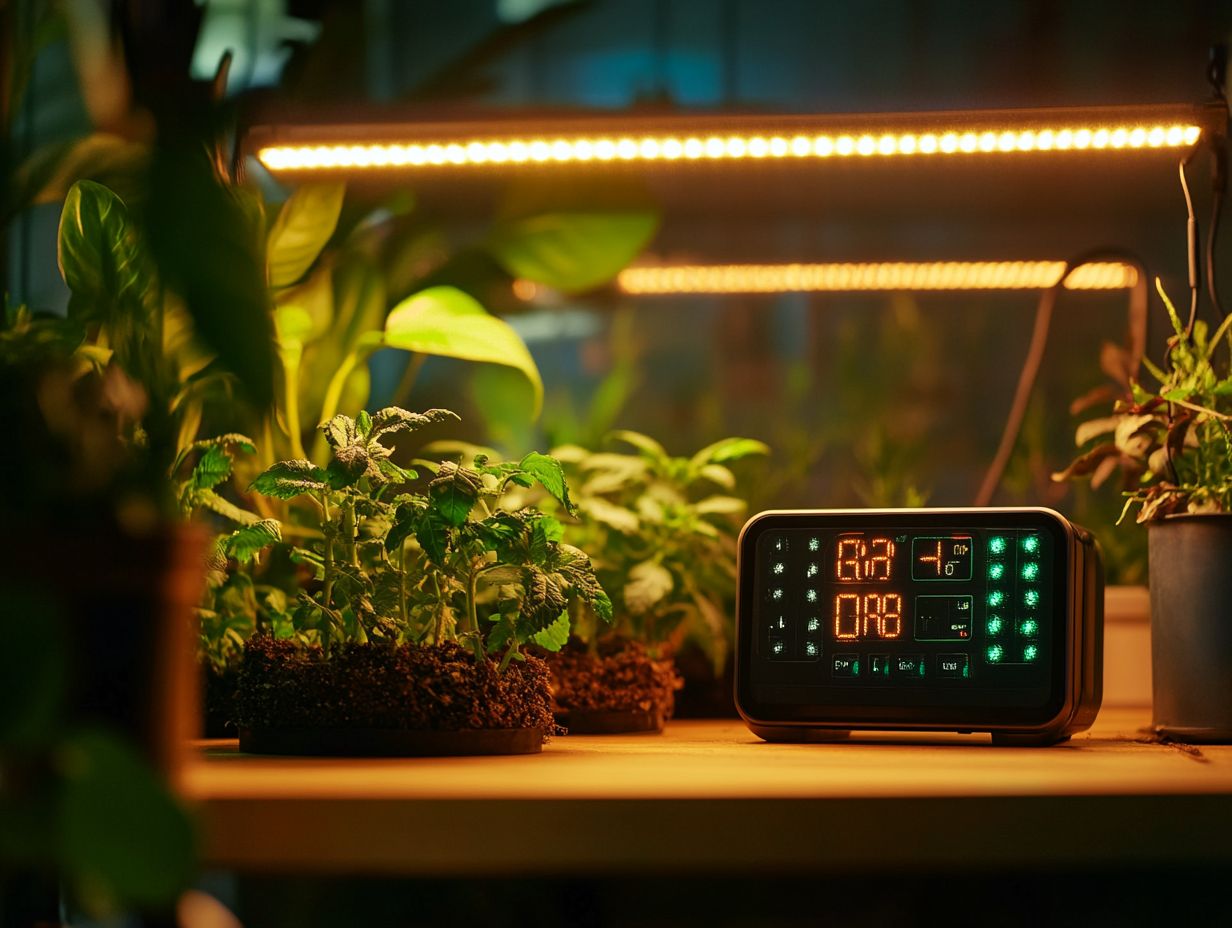
You ll find a variety of grow light timers on the market, each tailored to meet distinct gardening needs and preferences, allowing you to select the ideal option for your specific grow light system.
Manual timers offer a straightforward experience, while digital timers elevate the game with advanced features like programmable schedules, countdowns, and app integration for remote control.
Grasping the nuances between these options can significantly enhance your indoor gardening journey, especially as you customize your setup for optimal results.
Manual vs. Digital Timers
Choosing between manual and digital timers involves considering ease of use and your plants’ needs. Manual timers are simple, allowing basic on/off schedules.
Digital timers offer advanced features like customizable schedules and smart technology, optimizing light exposure.
This distinction can significantly impact how effectively you manage your lighting systems, especially given the diverse growth cycles of various plants. While manual timers may appeal to you for their simplicity and cost-effectiveness, they might not meet the needs of those who require more intricate timing sequences.
Conversely, digital timers can handle multiple grow light setups and can be programmed to sync with other environmental controls. However, their complexity might overwhelm novice users. Ultimately, understanding the benefits and limitations of each type will enable you to make an informed choice that best supports your plants’ developmental needs.
Single Outlet vs. Multiple Outlet Timers
Single outlet and multiple outlet timers provide different levels of control for your garden. A single outlet timer is great for simpler setups.
Multiple outlet timers let you manage several lights at once, perfect for optimizing your indoor environment.
When comparing these options, it’s crucial to consider how each aligns with your gardening goals. A single outlet timer can be a cost-effective choice if you’re just starting or maintaining a smaller setup, where ease of use and straightforward programming are essential.
On the flip side, multiple outlet timers shine when you’re ready to scale up. They can handle various light types and schedules, making them ideal for more complex systems that need advanced management. This versatility lets you integrate additional equipment, such as fans or humidifiers, providing a comprehensive approach to enhancing your indoor gardening efficiency.
Factors to Consider When Choosing a Timer
Choose the ideal grow light timer for your indoor garden. Several key factors ensure compatibility and optimal performance. Prioritize the timer s compatibility with your specific grow light system.
Look for features like programmable schedules and automation capabilities. These can significantly enhance your gardening experience. Explore customization options to elevate your lighting strategy, tailoring it to meet your unique needs.
Compatibility with Grow Light System
Ensuring compatibility with your specific grow light system is essential for both performance and safety. Different grow light systems come with varying power ratings and power requirements. Choose a timer that aligns with these specifications to protect your investment in plants and boost their growth!
Be aware that systems can operate on different voltages, such as 120V versus 240V. This directly influences your timer selection. If you opt for a timer not designed for your specific voltage, you risk malfunctions or hazards like overheating.
Moreover, varying frequency ratings can affect timing precision, vital for maintaining the light cycles necessary for optimal plant growth. Pay close attention to compatibility details between your timers and light systems to ensure all components work harmoniously together.
By staying vigilant, you create a robust growing environment that nurtures healthier plants.
Timer Features and Customization Options
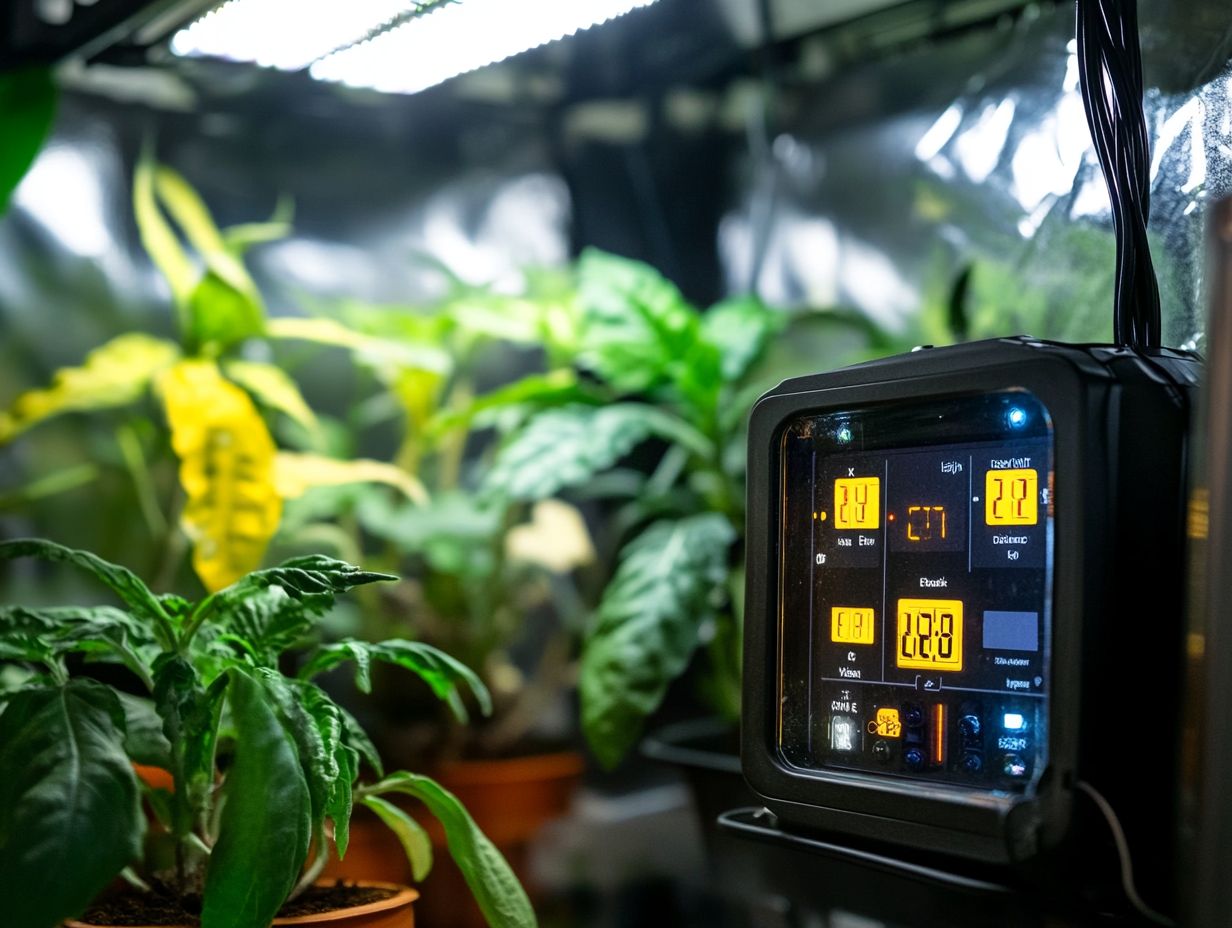
The features and customization options of grow light timers can significantly enhance their functionality and effectiveness. This allows you to fine-tune your lighting schedules to meet your plants’ specific needs. Programmable features like multiple on/off settings, countdown timers, and even smartphone connectivity provide the flexibility to adapt to various growing conditions.
This adaptability is vital since different plants flourish under distinct light conditions. Adjustments in duration and intensity optimize their growth. For example, certain species may thrive with extended light periods during their vegetative phase, while others might require shorter cycles to encourage flowering.
Advanced timers often come equipped with options for gradual dimming and brightening, mimicking natural sunlight transitions, which help reduce plant stress. Utilize these innovative tools to create a more controlled environment, fostering healthier plants and leading to more bountiful harvests.
How to Set Up and Use a Grow Light Timer
Setting up and using a grow light timer is a simple yet impactful process that can elevate your indoor gardening experience. Ensure your plants bask in the ideal lighting conditions required for robust growth.
Start by consulting the user manual tailored to your specific timer model. It expertly guides you through the essential steps for installation, programming, and fine-tuning your light schedule. With just a bit of attention, you’ll create an environment where your plants can thrive.
Step-by-Step Guide
To set up your grow light timer effectively, follow this comprehensive guide:
- Locate a suitable power source for your timer, then connect it to your grow light system according to the manufacturer’s instructions. Ensure all connections are secure and safe.
- Place the grow light timer in a dry, well-ventilated area to prevent overheating or water damage. Consult the user manual to familiarize yourself with your timer’s specific features.
- Program the timer to match your plants lighting needs, considering photoperiods and the types of plants you re growing. After programming, conduct a test run and monitor for any discrepancies.
- Always use insulated tools and wear safety goggles during installation to maintain a secure and hazard-free environment.
Get your timer set up today for thriving plants!
Troubleshooting Common Issues with Grow Light Timers
Troubleshooting common issues with grow light timers is crucial for maintaining an efficient indoor gardening system. Ensuring your plants receive optimal light exposure is essential for their health.
You may face challenges like timers failing to activate, incorrectly set schedules, or compatibility issues with your grow light systems. Addressing these problems promptly is key to your gardening success, as they can significantly affect the health and growth of your plants.
Common Problems and Solutions
Some challenges you might encounter with grow light timers include unexpected shut-offs, failure to turn on, or misaligned programming schedules.
Start by checking the power source and connections to ensure everything is secure. Consult the user manual for troubleshooting tips tailored to your specific model.
Your lights may not operate for the full duration you’ve set or may not follow the designated light cycle, which can negatively impact plant growth. A practical solution is to reset the timer according to the instructions provided, ensuring that all settings are accurately re-entered.
Verify that the timer is compatible with the energy requirements of your grow lights. Regular maintenance, such as checking for dust buildup on the timer and ensuring a suitable environment for optimal functioning, can help prevent future malfunctions.
Frequently Asked Questions

What are timers and why are they important for grow lights?
Timers are devices that can be programmed to turn on and off at specific times. They play a vital role in ensuring your plants receive consistent light cycles, crucial for their growth and development.
How do I set up a timer for my grow lights?
First, ensure you have a timer that is compatible with your grow lights. Plug the timer into an outlet and connect your grow lights to the timer. Then, set the desired on and off times using the timer’s instructions.
Can I use a regular household timer for my grow lights?
It’s recommended to use a timer specifically designed for grow lights. Regular household timers may not handle the energy requirements of grow lights properly, potentially causing damage to both the timer and the lights.
How often should I change the timer settings for my grow lights?
Your plants’ needs will guide how often you change the timer settings. Research the recommended light cycle for each specific plant and adjust the timer accordingly.
Can I use multiple timers for my grow lights?
Yes, you can use multiple timers if you have a large grow space or different types of plants requiring distinct light cycles. Just ensure each timer is properly set up and synced for consistent light cycles.
What is the benefit of using timers for my grow lights?
Timers provide a convenient and efficient way to control your plants’ light cycles. They help save energy and reduce the risk of human error in manually turning the lights on and off.
Ready to optimize your indoor garden? Start troubleshooting your grow light timer today!




